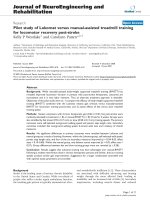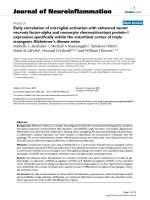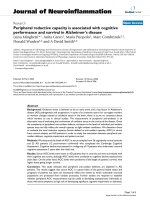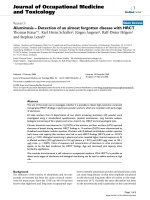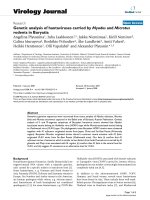Báo cáo hóa học: "Early detection of urothelial premalignant lesions using hexaminolevulinate fluorescence cystoscopy in high risk patients" potx
Bạn đang xem bản rút gọn của tài liệu. Xem và tải ngay bản đầy đủ của tài liệu tại đây (208.64 KB, 4 trang )
MET H O D O LO G Y Open Access
Early detection of urothelial premalignant lesions
using hexaminolevulinate fluorescence
cystoscopy in high risk patients
Salvatore Blanco
1*
, Marco Raber
1
, Biagio Eugenio Leone
2
, Luca Nespoli
3
, Marco Grasso
1*
Abstract
Background: To evaluate fluorescence cystoscopy with hexaminolevulinate (HAL) in the early detection of
dysplasia (DYS) and carcinoma in situ (CIS) in select high risk pa tients.
Methods: We selected 30 consecutive bladder cancer patients at high risk for progression. After endoscopic
resection, all patients received (a) induction BCG schedule when needed, and (b) white light and fluorescence
cystoscopy after 3 months. HAL at doses of 85 mg (GE Healthcare, Buckinghamshire, United Kingdom) dissolved in
50 ml of solvent to obtain an 8 mmol/L solution was instilled intravesically with a 12 Fr catheter into an empty
bladder and left for 90 minutes. The solution was freshly prepared immediately before instillation. Cystoscopy was
performed within 120 minutes of bladder emptying. Standard and fluorescence cystoscopy was performed using a
double light system (Combilight PDD light source 5133, Wolf, Germany) which allowed an inspection under both
white and blue light.
Results: The overall incidence was 43.3% dysplasia, 23.3% CIS, and 13.3% superficial transitional cell cancer. In 21
patients, HAL cystoscopy was positive with one or more fluorescent flat lesions. Of the positive cases, there were
4 CIS, 10 DYS, 2 association of CIS and DYS, 4 well-differentiated non-infiltrating bladder cancers, and 1 chronic
cystitis. In 9 patients with negative HAL results, random biopsies showed 1 CIS and 1 DYS. HAL cystoscopy showed
90.1% sensitivity and 87.5% specificity with 95.2% positi ve predictive value and 77.8% negative predictive value.
Conclusion: Photodynamic diagnosis should be considered a very important tool in the diagnosis of potentially
evolving flat lesions on the bladder mucosa such as DYS and CIS. Moreover, detection of dysplasic lesions that are
considered precursors of CIS may play an important role in preventing disease progression. In our opinion, HAL
cystoscopy should be recommended in the early follow-up of high risk patients.
Introduction
Bladder cancer is costly in both human and societal
terms, yet the level of awareness of the disease and its
early symptoms is low among the public and health care
professionals. There is also a poor understanding of the
potential causative role played by exposure to workplace
carcinogens [1].
Transitional cells cancer is the most common bladd er
neoplasm and his infiltrating form may heavily affect the
patient survival. In this regard the main challenge is to
early diagnose aggressive cancer yet in a limited stage or
better while it has not became infiltrating. A part of
superficial bladder cancers indeed may recur even sev-
eral times after primary resection without showing any
worsening in their malignant potential. In some cases
they come through the lamina propria, the deep submu-
cosa and muscular wall showing a clear infiltrating
course. Unfortunately the biological reasons of this radi-
cal changing of tumor behaviour are not well under-
stood. However, the p resence of non-papillary
carcinoma in situ (CIS) is really considered a source of
invasive bladder cancer [2]. Furthermore, it has been
documented that even in patient s with papillary disease,
most invasive cancers develop from adjacent areas of
carcinoma in situ [3]. However, in order to modify t he
natural history of bladder cancer an earlier diagnosis
* Correspondence: ;
1
Department of Urology, San Gerardo Hospital, University of Milano-Bicocca,
Monza, Italy
Full list of author information is available at the end of the article
Blanco et al. Journal of Translational Medicine 2010, 8:122
/>© 2010 Blanco et al; licensee BioMed Central Ltd. This is an Open Acces s article distribute d under the terms of the Creative Commons
Attribution License ( which permits unrestricted use, distribution, and reproduction in
any medium, provided the origina l work is prop erly cited.
might be done by identification of a known precursor of
CIS called severe dysplasia (DYS) [4,5]. Dysplasia is
often located in normal-appearing bladder mucosa and
can be easily missed under standard white-light (WL)
cystoscopy [6]. Voided-urine cytology has proven useful
as a non-invasive adjunct in the detection of CIS,
although its sensitivity in the detection of DYS may be
questionable [7,8].
Several investigators have used photodynamic age nts
to detect dysplastic urothelium [ 9,10]. Zaak et al pre-
viously concluded that 5-aminolevulinic acid (5-ALA)
prov ided the most efficient diagnostic agent for patients
with flat, high-risk urothelial lesions (CIS and DYS)
compared with WL cystoscopy and cytology [11]. In our
study, we used a recently introduced, more lipophylic
ester of 5-ALA, hexaminolevulinate (HAL) to study DYS
and CIS, and compared the detection rate with this
agen t to that of classic WL cysto scopy and fluo rescence
cystoscopy in select high risk patients.
Materials and methods
Between March 2007 and February 2008, 30 consecutive
bladder cancer patients at high risk for progression were
selected. Patients if needed started a BCG induction sche-
dule within 30 days (once weekly for 6 weeks). The fol-
lowing WL and HAL cystoscopy control was performed
after 3 month s in order to minimize the likelihood of
false positives [12,13]. Patients with porphyria, gross
haematuria, acute urinary tract infection, multi-drug
allergies, and women not on adequate contraceptive mea-
sures or who were breast feeding were excluded [14].
HAL at doses of 85 mg (GE Healthcare, Buckingham-
shire, United Kingdom) dissolved in 50 ml of solv ent to
obtain an 8 mmol/L solution was instilled intravesically
with a 12 Fr catheter into an empty bladder and left for
90 minutes. The solution was freshly prepared immed i-
ately before instillation. Cystoscopy was performed
within 120 minutes of bladder emptying as described
below.
The surface of the bladder absorbs the HAL solution
and converts it to the endogenous pigment, protopor-
phyrin IX. This pigment is selectively deposited in the
tumour and causes fluorescence in the red-range when
excited by blue-violet light. The comparison of HAL
with standard cystoscopy was performed using a within-
patient design by inspecting the bladder under WL first,
followed by blue light (fluorescence). Because cystoscopy
was combined with the immediate resection of suspi-
cious lesions, all patients received sedation or spinal
anaesthesia. Before endoscopic inspection, the bladder
was evacuated. Standard and fluorescence cystoscopy
was performed using a double light system (Combilight
PDD light source 5133, Wolf, Germany) which allowed
an inspection under both white and blue light.
The purpose of preliminary WL cystoscopy was to
identify and note any exophytic lesions and suspicious
areas in the bladder chart. Subsequently, under blue
light cystoscopy, we aimed to determine the number
and location of all fluorescing areas on the same bladder
chart. In patients without suspicion, 5 random biopsies
were taken from normal appearing urothelium.
All biopsies and resected materials were analyzed by a
single pathologist blinded to the fluorescence cystoscopy
results. Lesions were staged and graded according to the
2004 WHO classification [15].
Safety assessments, including physical examinations,
vital signs, and blood sampling for hematology and bio-
chemistry were performed at baseline and again 24
hour s after HAL insti llation. All spontaneously reported
and observed adverse events were documented during
the hospital stay. Patients were followed for roughly 10
days until the consultation of their histologic results and
were interviewed for any adverse effects after hospital
discharge.
Categorical data were examined by chi-square test,
while continuous variables were evaluated by the t-test.
Specificity, sensitivity, positive predictive value (PPV),
and negative predictive value (NPV) were calculated
with the usual mathematical formulas.
Results
Of the 30 patients, 24 were males and 6 were females.
Their mean age was 67 (SD, 7.8; range, 46-76) years.
For 11 patients, high risk transitional cancer was the
first episode while in the remaining patients high risk
episode was recurrent. (range , 2-11 resections; average
2.8 resections). In all patients, WL cystosco py was nega-
tive. Urinary cytology was positive in 9 patients and sus-
pected in 4 cases.
The overall incidence of D YS was 43.3% (13/30), CIS
was 23.3% (7/30), and superficial transitional cell cancer
was 13.3% (4/30). D isease-free follow-up occurred in
26.7% (8/30) of patients. In 21 patients, the HAL cysto-
scopy was positive, with one or more fluorescing flat
lesionspresent(mean±SD,2.7±1.4;range1-5).The
positivecasesconsistedof4CIS,10DYS,and2associa-
tions of CIS and DYS, well-differentiated superficial blad-
der cancer non-infiltrating to the lamina propria in 4
cases, and chronic cystitis in 1 case. In 9 patients with
negative results by HAL, the 6 random biopsies showed
one case each of CIS and DYS. HAL cystoscopy showed
90.1% sensitivity (95% CI, 0.53-0.87) and 87.5% specificity
(95% CI, 0.47-0.99) and 95.2% PPV (95% CI, 0.74-0.99)
and 77.8 NPV (95% CI, 0.40-0.96). CIS and DYS were
both visible as a bril liant-red, well-limited fluorescence
area in contrast with the normal adjacent urothelium.
HAL fluorescence cystoscopy was well tolerated and
no unexpected events were reported.
Blanco et al. Journal of Translational Medicine 2010, 8:122
/>Page 2 of 4
Discussion
Bladder cancer risk categories are based on clinical and
histopathologic parameters such as number of tumours,
tumour size, prior recurrence rate, T category, presence
of concomitant CIS, and tumour grade [16,17]. Among
these, CIS is considered an important risk factor for dis-
ease progression because specific survival is heavily
affected by t he presen ce of CIS alone or associated with
papillary superficial bladder cancer and non papillary T1
tumours [18]. So it should be necessary an earlier diag-
nosis when mucosal changes are still precursor of CIS.
DYS is considered an epithelial abnormality appearing
as a flat lesion on the bladder mucosa and a precursor
of CIS [19]. This premalignant lesion might have impor-
tant implications in the early diagnosis of bladder cancer
progression. Several recent studies have shown that con-
comitant or single DYS is associated with a considerable
risk for disease progression [20-22]. However, diagnosis
is very difficult because, in the early stages, both lesions
are indistinguisha ble from the normal-appearing bladder
mucosa [6] and urine cytology testing might not be suf-
ficiently sensitive [23].
The situation can be significantly improved with the
use of photo sensitizers, e.g. 5-ALA or HAL, which can
be safely administered intravesically and make these flat
lesions visible within an otherwise normal bladder
mucosa. Our results confirm the advantage in the diag-
nosis of potentially evolving flat lesions (DYS and CIS)
on the bladder mucosa examined by photodynamic,
rather than classic WL, cystoscopy. A real benefit was
shown in the diagnosis of early papillary superficial
bladder tumours that were not yet visible, confirming
previous observations [24-28].
Regarding dysplasia, in a previous study, Zaak et al.
concluded that photodynamic diagnosis using 5-ALA
was an efficient diagnostic technique for patients with
flat, high-risk urothelial lesions compared with classic
WL cystoscopy and cytology [11]. In our study, we used
HAL, a potent ester of aminolevulinic acid, that provides
better selectivity, brighter fluorescence, and requires a
shorter instillation time [29,30].
Another point of discussion is the incidence of DYS
and CIS, which was 43.3% and 23.3%, respectively, in
our study. This means that 66.6% of our patients had a
potential evolving flat lesion. In the absence of photody-
namic diagnosis, the incidence of such lesions would
have been only 6.7%. These results suggest the careful
consideration of all therapeutic possibilities, beginning
with the careful endoscopic resection, as well as the
therapeutic effect of immunoprophylaxis in these high
risk patients. Because bladder cancer is often multi-
centric, particularly when it is of high grad e, a standard
WL resection might miss inv isible tumours. Moreover, a
BCG induction schedule might be not sufficient to t reat
these lesions making treated indeed during maintenance
schedule. However, the detection rate of these otherwise
undiagnosed lesions is higher with photodynamic
screening.
The limitations of this study are the small number of
patients included. However, we feel that this limitation
is balanced by the highly selected series.
Further studies a re needed to determine whether this
important and not inexpensive diagnostic tool must be
reserved for primary or secondary look resections of
high risk patients and if the improvement in the rate of
detection of flat lesions in the follow-up may improve
the use of additional treatment and the prognosis of
these patients.
Conclusions
Photodynamic diagnosis should be considered a very
important tool in the diagnosis of potentially evolving
flat lesions on the bladder mucosa such as DYS and
CIS. Moreover, detection of dysplasic lesions that are
considered precursors of CIS may play an important
role in preventing disease progression. In our opinion,
HAL cystoscopy should be recommended in the early
follow-up of high risk patients.
Author details
1
Department of Urology, San Gerardo Hospital, University of Milano-Bicocca,
Monza, Italy.
2
Department of Clinical Pathology, Desio Hospital, University of
Milano-Bicocca, Monza, Italy.
3
Department of Surgery, San Gerardo Hospital,
University of Milano-Bicocca, Monza, Italy.
Authors’ contributions
SB has conceived the study and participated in its draft and design. MR has
participated in its design and draft. BEL has carried out the histological
analysis. LN has participated in its revision. MG has conceived the study and
participated in its design and coordination. All authors read and approved
the final manuscript.
Competing interests
The authors declare that they have no competing interests.
Received: 20 October 2010 Accepted: 22 November 2010
Published: 22 November 2010
References
1. Grasso M: Bladder Cancer: a major public health issue. Eur Urol Suppl
2008, 7:510-5.
2. Herr HW: Natural history of superficial bladder tumors: 10- to 20-year
follow-up of treated patients. World J Urol 1997, 15:84.
3. Koss LG: Mapping of the urinary bladder: its impact on concepts of
bladder cancer. Hum Patol 1979, 10:533-548.
4. Murphy WM, Busch C, Algaba F: Intraurothelial lesions of urinary bladder:
morphologic considerations. Scand J Urol Nephrol 2000, 205(Suppl):67-81.
5. Mostofi FK, Davis CJ, Sesterhenn I: Histological typing of urinary bladder
tumours. World Health Organization international histological classification of
tumours Berlin: Springer; 1999.
6. Soloway MS, Murphy W, Rao MK Cox C: Serial multiple-site biopsies in
patients with bladder cancer. J Urol 1978, 120:57-59.
7. Murphy WM: Current status of urinary cytology in the evaluation of
bladder neoplasms. Hum Pathol 1990, 21:886-896.
Blanco et al. Journal of Translational Medicine 2010, 8:122
/>Page 3 of 4
8. Bastacky S, Ibrahim S, Wlczynski SP, Murphy WM: The accuracy of urinary
cytology in daily practice. Cancer 1999, 87:118-128.
9. Kriegmair M, Knuchel R, Stepp H, Hofstaedter F, Hofstetter A: Detection of
early bladder cancer by 5-aminolevulinic acid induced porphyrin
fluorescence. J Urol 1996, 155:105-110.
10. Jichlinski P, Forrer M, Mizeret J, et al: Clinical evaluation of a method for
detecting superficial surgical transitional cell carcinoma of the bladder
by light-induced fluorescence of protoporphyrin IX following the topical
application of 5-aminolevulinic acid: preliminary results. Lasers Surg Med
1997, 20:402-408.
11. Zaak D, Hungerhuber E, Schneede P, Stepp H, Frimberger D, Corvin S,
Schmeller N, Kriegmair M, Hofstetter A, Knuechel R: Role of 5-
Aminolevulinic Acid in the Detection of Urothelial Premalignant Lesions.
Cancer 2002, 95:2580.
12. Colombo R, Naspro R, Bellinzoni P, et al: Photodynamic diagnosis for
follow-up of carcinoma in situ of the bladder. Ther Clin Risk Manag 2007,
3(6):1003-7.
13. Grimbergen MC, van Swol CF, Jonges TG, et al: Reduced specifi city of 5-
ALA induced fluorescence in photodynamic diagnosis of transitional cell
carcinoma after previous intravesical therapy. Eur Urol 2003, 44(1):51-6.
14. Schmidbauer J, Witjes F, Schmeller N, Donat R, Susani M, Marberger M,
Hexvix PCB301/01 Study Group: Improved detection of urothelial
carcinoma in situ with hexaminolevulinate fluorescence cystoscopy. J
Urol 2004, 171(1):135-8.
15. Algaba F, Amin M, et al: Tumours of the urinary system: non invasive
urothelial neoplasias. In WHO classification of tumours of the urinary system
and male genital organs. Edited by: Eble JN, Sauter G, Epstein JI, Sesterhenn
I. Lyon: IARCC Press; 2004.
16. Millan-Rodriguez F, Chechile-Toniolo G, Salvador-Bayarri J, Palou J, Algaba F,
Vicente-Rodriguez J: Primary superficial bladder cancer risk groups
according to progression, mortality and recurrence. J Urol 2000, 164(3 Pt
1):680-684.
17. Sylvester RJ, van der Meijden AP, Oosterlinck W, Witjes A, Bouffioux C,
Denis L, Newling DW, Kurth K: Predicting recurrence and progression in
individual patients with stage TaT1 bladder cancer using EORTC risk
tables: a combined analysis of 2596 patients from seven EORTC trials.
Eur Urol 2006, 49(3):466-477.
18. Fukui I, Yokokawa M, Sekine H, et al: Carcinoma in situ of the urinary
bladder. Effect of associated neoplastic lesions on clinical course and
treatment. Cancer 1987, 59:164-73.
19. Lopez-Beltran A, Cheng L, Anderson L, et al: Preneoplastic non-papillary
lesions and conditions of the urinary bladder: an update based on the
Ancona international consultation. Virchows Arch 2002, 440:3-11.
20. Althausen AF, Prout GR, Daly JJ: Non-invasive papillary carcinoma of the
bladder associated with carcinoma in situ. J Urol 1976, 116:575-580.
21. Kiemeney LA, Witjes JA, Heijbroek RP, Debruyne FM, Verbeek AL: Dysplasia
in normal-looking urothelium increases the risk of tumour progression
in primary superficial bladder cancer. Eur J Cancer 1994, 30A:1621-1615.
22. Cheng L, Cheville JC, Neumann RM, Bostwick DG: Flat intraepithelial
lesions of the urinary bladder. Cancer 2000, 88:625-631.
23. Cheng L, Chevilee JC, Neumann RM, Bostwick DG: Natural history of
urothelial dysplasia of the bladder. Am J Surg Pathol 1999, 23:443-447.
24. Grossman HB: Improving the management of bladder cancer with
fluorescence cystoscopy. J Environ Pathos Toxicol Oncol 2007, 26:143-7.
25. Fradet Y, Grossman HB, Gomella L, et al: A comparison of
hexaminolevulinate fluorescence cystoscopy and white light cystoscopy
for the detection of carcinoma in situ in patients with bladder cancer: a
phase III, multicenter study. J Urol 2007, 178:68-73.
26. Grossman HB, Gomella L, Fradet Y, et al: A phase III, multicenter
comparison of hexaminolevulinate fluorescence cystoscopy and white
light cystoscopy for the detection of superficial papillary lesions in
patients with bladder cancer. J Urol 2007, 178:62-7.
27. Jichlinski P, Guillou L, Karlsen SJ, et al: Hexyl aminolevulinate fluorescence
cystoscopy: new diagnostic tool for photodiagnosis of superficial
bladder cancer - a multicenter study. J Urol 2003, 170:226-9.
28. Jocham D, Witjes F, Wagner S, Zeylemaker B, van Moorselaar J, Grimm MO,
Muschter R, Popken G, König F, Knüchel R, Kurth KH: Improved detection
and treatment of bladder cancer using hexaminolevulinate imaging: a
prospective, phase III multicenter. J Urol 2005, 174(3):862-6.
29. Kloek J, Akkermans W, Beijersbergen van Henegouwen GM: Derivatives of
5 aminolevulinic acid for photodynamic therapy: enzymatic conversion
into protoporphyrin. Photochem Photobiol 1998, 67:150.
30. Marti A, Lange N, van den Bergh H, Sedmera D, Jichlinski P, Kucera P:
Optimisation of the formation and distribution of protoporphyrin IX in
the urothelium: an in vitro approach. J Urol 1999, 162:546.
doi:10.1186/1479-5876-8-122
Cite this article as: Blanco et al.: Early detection of urothelial
premalignant lesions using hexaminolevulinate fluorescence cystoscopy
in high risk patients. Journal of Translational Medicine 2010 8:122.
Submit your next manuscript to BioMed Central
and take full advantage of:
• Convenient online submission
• Thorough peer review
• No space constraints or color figure charges
• Immediate publication on acceptance
• Inclusion in PubMed, CAS, Scopus and Google Scholar
• Research which is freely available for redistribution
Submit your manuscript at
www.biomedcentral.com/submit
Blanco et al. Journal of Translational Medicine 2010, 8:122
/>Page 4 of 4




